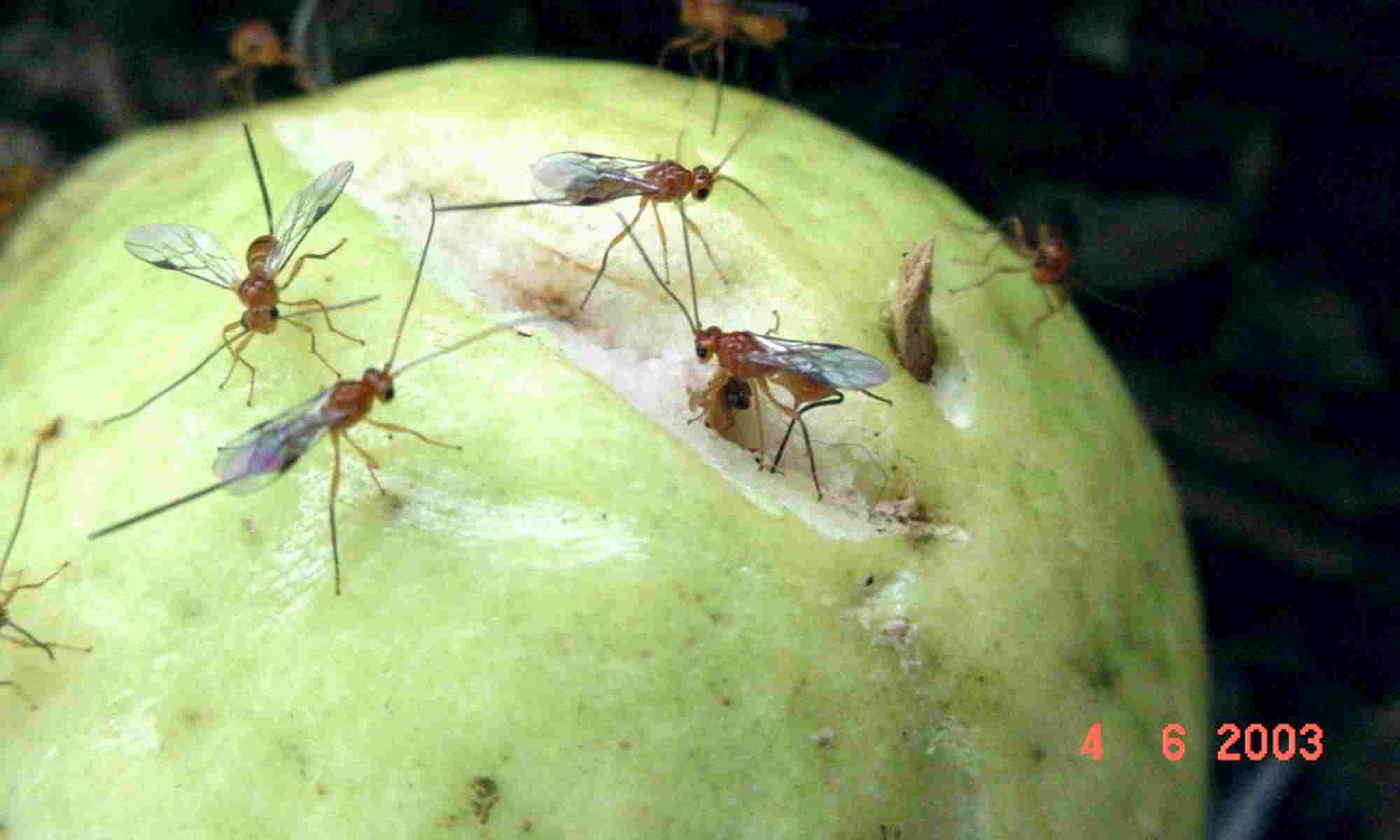- Version
- Download 6
- File Size 1.65 MB
- Create Date 11/06/2021
- Download
SANTOS, Dáffine Oliveira. Inibição do florescimento natural de abacaxizeiro após a aplicação de reguladores de crescimento. 2014. 77 p. Dissertação (Mestrado em Produção Vegetal no Semiárido) – Universidade Estadual de Montes Claros, Janaúba, 2014.
A indução floral natural do abacaxizeiro é um dos grandes problemas da cultura, podendo desencadear em uma floração desuniforme gerando prejuízos para a atividade. Em razão disso, foram conduzidos dois experimentos cujo objetivo foi determinar os efeitos de dois reguladores de crescimento sobre as características vegetativas, florescimento natural e qualidade dos frutos do abacaxi ‘Pérola’, ‘Vitória’ e ‘IAC Fantástico’. Os experimentos foram conduzidos em área experimental no município de Janaúba – MG. A cultura foi conduzida em fileira dupla no espaçamento de 0,9 x 0,4 x 0,3 m. O primeiro experimento foi montado no delineamento em blocos casualizados, utilizando o regulador de crescimento 1-metilciclopropeno. As avaliações de crescimento vegetativo foram feitas no esquema parcelas subdivididas no espaço e no tempo (5 x 3 x 8), com quatro repetições, sendo cinco tratamentos referentes a concentrações de 1-MCP, T1: controle, 0,00 mg L-1; T2: uma aplicação semanal, totalizando oito aplicações na concentração de 37,5 mg L-1; T3: uma aplicação a cada 14 dias, totalizando quatro aplicações na concentração de 75 mg L-1; T4: uma aplicação semanal, totalizando oito aplicações na concentração de 75 mg L-1; T5: uma aplicação a cada 14 dias, totalizando quatro aplicações na concentração de 150 mg L-1, na parcela, três cultivares comerciais de abacaxizeiro (‘Pérola’, ‘Vitória’, e ‘IAC Fantástico’) na subparcela e nove épocas de avaliações na subparcela. Para a porcentagem de florescimento natural, mortalidade de plantas e qualidade dos frutos, o esquema foi de parcelas subdivididas no espaço (5 x 3), com quatro repetições, sendo cinco tratamentos referentes às concentrações de 1-MCP na parcela; três cultivares comerciais de abacaxizeiro (‘Pérola’, ‘Vitória’ e ‘IAC Fantástico’) na subparcela. O segundo experimento foi montado no delineamento em blocos casualizados, utilizando o regulador de crescimento ácido 2-(3- clorofenoxi) propiônico. As avaliações de crescimento vegetativo foram feitas no esquema parcelas subdivididas no espaço e no tempo (5 x 2 x 10), com quatro repetições, sendo cinco tratamentos referentes a concentrações de ACP, 0, 30, 90, 120 e 150 mg L-1 com aplicações a cada 14 dias totalizando quatro aplicações, na parcela, duas cultivares comerciais de abacaxizeiro (‘Pérola’ e ‘Vitória’) na subparcela e dez épocas de avaliações na subparcela. Para a porcentagem de florescimento natural, mortalidade de plantas e qualidade dos frutos o esquema foi de parcelas subdivididas no espaço (5 x 2), com quatro repetições, sendo cinco tratamentos referentes a concentrações de ACP, na parcela; duas cultivares comerciais de abacaxizeiro (‘Pérola’ e ‘Vitória’), na subparcela. Cada parcela foi composta por 60 plantas, 20 plantas de cada cultivar, em que todas as plantas foram utilizadas para avaliação do experimento. As características avaliadas foram: diâmetro do talo ao nível do solo; comprimento da folha D; número de folhas somando as folhas emitidas mês a mês; florescimento natural no primeiro e segundo ano após o plantio e o total acumulado; mortalidade de plantas acumulada; peso médio do fruto com e sem coroa; comprimento do fruto com e sem coroa; diâmetro médio dos frutos; firmeza dos frutos; sólidos solúveis; acidez titulável; relação SS/AT e potencial hidrogeniônico. No primeiro experimento, para o diâmetro do talo, comprimento de folha D e número de folhas emitidas foi observado efeito significativo da interação das cultivares e época de avaliação nas diferentes concentrações de 1-metilciclopropeno (1-MCP). Na análise de florescimento natural e mortalidade de plantas, observou-se efeito significativo apenas das cultivares sobre as características estudadas. A aplicação do 1-MCP não apresentou efeito significativo. Na avaliação da qualidade dos frutos constatou-se que houve efeito significativo isolado dos tratamentos com 1-MCP e cultivares sobre as características estruturais e físico-químicas dos frutos, exceto para a acidez titulável (AT), pH e a relação SS/AT (RATIO). No segundo experimento verificou-se interação significativa entre as épocas de avaliação (dias após o plantio) e as doses da solução de ACP sobre as características de desenvolvimento vegetativo, havendo o decréscimo do desenvolvimento das plantas. Foram observados alguns efeitos fitotóxicos nas plantas de abacaxi, como anomalias e até mesmo morte de plantas, causada pelo ACP. Observou-se a inexistência de efeito significativo dos fatores estudados sobre o florescimento natural do primeiro ano e mortalidade das plantas. Porém, foi observado efeito significativo das concentrações de ACP sobre o florescimento natural do segundo ano, florescimento natural total acumulado. Na avaliação das características estruturais e físico-químicas dos frutos, não houve efeito significativo das concentrações de ACP e cultivares.
Palavras-chave: Ananas comosus var. comosus. 1-Metilciclopropeno. Ácido 2-(3- clorofenoxi) propiônico.
Inhibition of natural flowering of pineapple after application of growth regulators
The natural flowering of pineapple is one of the major problems of culture, which can trigger on an uneven flowering generating losses for the activity. For that reason, two experiments were carried out to determine the effects of two growth regulators on vegetative characteristics, natural flowering and quality of ‘Pérola’, ‘Vitória’ and ‘IAC Fantastico’ pineapple fruit. The experiments were conducted in the experimental area in Janaúba city, state of Minas Gerais. The culture was planted in double rows spaced at 0.9 x 0.4 x 0.3 m. The first experiment was arranged in a randomized block design using the regulator growth 1-methylcyclopropene. The vegetative growth evaluations were conducted in split plot scheme in space and time (5 x 3 x 8) with four replications, with five treatments concerning concentrations of 1-MCP, T1: control, 0.00 mg L-1; T2: one weekly application, totaling eight applications at a concentration of 37.5 mg L-1; T3: one application every 14 days, totaling four applications at a concentration of 75 mg L-1; T4: a weekly application, totaling eight applications at a concentration of 75 mg L-1; T5: an application every 14 days, totaling four applications at a concentration of 150 mg L-1, in the plot, three commercial pineapple cultivars (‘Pérola’, ‘Vitória’ and ‘IAC Fantastico’) in the subplot, and nine times of evaluation in the subplot. For the percentage of natural flowering, mortality of plants and fruit quality, the scheme was split plot in space (5 x 3), with four replications, with five treatments concerning to concentrations of 1-MCP in the parcel; three commercial pineapple cultivars (‘Pérola’, ‘Vitória’ and ‘IAC Fantastico’) in the subplot. The second experiment was conducted in a randomized block design using the growth regulator 2-(3-chlorophenoxy) propionic acid. The evaluations of vegetative growth were conducted in split plot scheme in space and time (5 x 2 x 10) with four replications, with five treatments concerning to ACP concentrations, 0, 30, 90, 120 and 150 mg L-1 with applications every 14 days totaling four applications, in the plot; two commercial pineapple cultivars (‘Pérola’ and ‘ Vitória’) in the subplot and ten times of evaluations in the subplot. For the percentage of natural flowering, mortality of plants and fruit quality, the scheme was split plot in space (5 x 2), with four replications, with five treatments concerning concentrations of ACP in the parcel; two commercial cultivars of pineapple (‘Pérola’ and ‘ Vitória’) in the subplot. Each plot consisted of 60 plants, 20 plants of each cultivar, in which all the plants were used for evaluation of the experiment. The evaluated characteristics were stem diameter at ground level; length of the D leaf; number of leaves adding leaves grown every month; natural flowering in the first and second year after planting and the total accumulated; accumulated mortality of plants; average fruit weight with and without crown; fruit length with and without crown; average fruit diameter; fruit firmness; soluble solids; titratable acidity; SS/TA ratio and hydrogen potential. In the first experiment, for stem diameter, leaf length and number of D leaf grown, it was observed a significant interaction of cultivars and assessment time in different concentrations of 1-methylcyclopropene (1-MCP). In the analysis of natural flowering and mortality of plants, there was a significant effect only on the characteristics of the cultivars studied. Application of 1-MCP had no significant effect, that may be due to the product formulation that when it is mixed with water it becomes a gas. In evaluating the fruit quality, it was found that there was isolated significant effect of treatments with 1-MCP and cultivars on the structural and physical-chemical characteristics of fruits, except for titratable acidity (TA), pH and SS / TA ratio. In the second experiment there was a significant interaction between evaluation periods (days after planting) and doses of ACP solution on the characteristics of vegetative development, with the decrease of plant development. Some phytotoxic effects on pineapple plants, such as anomalies and even plant death caused by ACP were observed. There was a lack of significant effect of the factors studied on the natural flowering in the first year and plant mortality. However, significant effect of concentrations of ACP on the natural flowering of the second year, the total accumulated natural flowering was observed. In the evaluation of structural and physical-chemical characteristics of fruits, there was no significant effect of concentrations of ACP and cultivars.
Keywords: Ananas comosus var. comosus. 1-methylcyclopropene. 2-(3-chlorophenoxy) propionic acid

